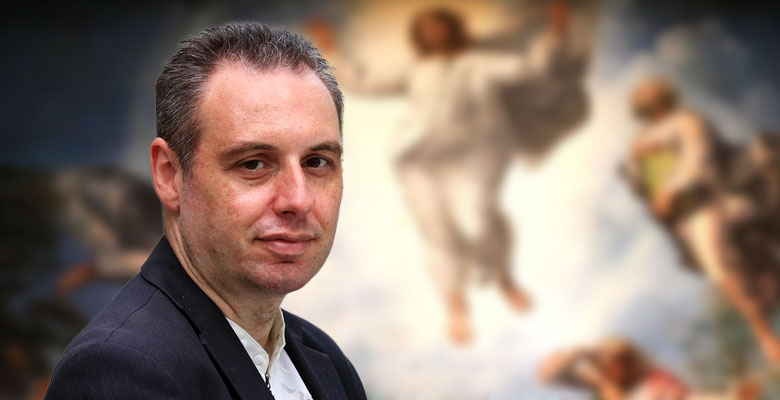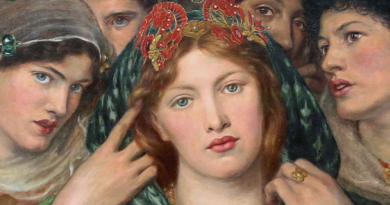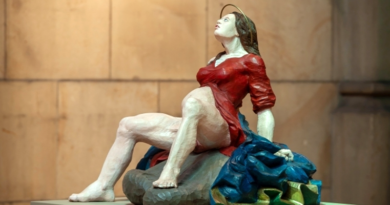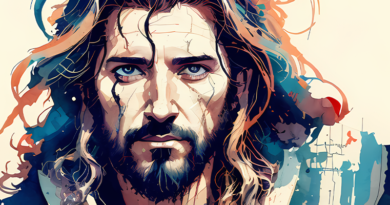Aurelio Porfiri – Sacred Art Is Eternal
Sacred art is neither ancient nor modern. Sacred art is eternal! It’s in that harmony of sounds and colors that leads us to the contemplation of divine things.
 By Aurelio Porfiri/Daily Compass – Our era seems to impose a disfigured art on artists in the name of modernity at all costs. But the sacred artist knows well that even novelty is grafted onto the branch of Scripture and tradition, to ultimately lead to contemplation.
By Aurelio Porfiri/Daily Compass – Our era seems to impose a disfigured art on artists in the name of modernity at all costs. But the sacred artist knows well that even novelty is grafted onto the branch of Scripture and tradition, to ultimately lead to contemplation.
It can truly be said that our era is full of a ferocious determinism whereby certain things must be one way and cannot be others. It seems strange in a time when, among the watchwords, the slogan that everything is possible resonates.
Let’s take art: you are not a contemporary artist if you do not choose the abstract, or the atonal for those who are musicians. Anyone who tries to continue in the footsteps of the ancients is viewed with contempt, as if they were nothing more than a grim mannerist whose time has long passed.
.
Let’s take art: you are not a contemporary artist if you do not choose the abstract, or the atonal for those who are musicians. Anyone who tries to continue in the footsteps of the ancients is viewed with contempt, as if they were nothing more than a grim mannerist whose time has long passed.
Far be it from us to despise the achievements that modernity has brought us, even in the artistic field, but they can only be appreciated when they are grafted onto a tradition. All this is even more true when we talk about sacred art, sacred music. No one rejects the new out of bias. Anyone who takes refuge in the past out of fear is certainly not to be recommended. But we cannot forget the important principle that one cannot be modern if one has not first been ancient.
The sacred artist knows well that he must refer to some things that come not only from tradition, but also from Scripture. The event of the incarnation raised the dignity of the human figure not only as regards its spiritual essence, but also as regards the figure itself.
Let us remember what Saint Paul says in the Letter to the Philippians: «Have in yourselves the same feelings that were in Christ Jesus, who, although of a divine nature, did not consider his equality with God a jealous treasure; but he emptied himself, taking the form of a servant and becoming like men; appearing in human form, he humiliated himself by becoming obedient to the point of death and death on a cross. Therefore God exalted him and gave him the name which is above every name; so that at the name of Jesus every knee should bow in heaven, on earth and under the earth; and let every tongue proclaim that Jesus Christ is Lord, to the glory of God the Father” ( Phil 2:5-11). In the incarnation Christ exalted man in body and soul, matter and spirit, and sacred art penetrates the soul into the deepest recesses through the materiality of sounds, shapes and colors.
A very significant text by the writer Martin Mosebach is entitled “The heresy of the formless”. It is indeed a very appropriate title, even if the book refers mainly to the liturgy. It is important for us to reflect on the fact that the formless is chaos and that art and music aimed at God should instead reflect the order and beauty that have their culmination and source in the Creator.
Here is the importance of drawing in painting , which can certainly have modern features but which must not betray the logic of incarnation. The great English art critic John Ruskin, in a text that deals with the elements of drawing, states: «For I am convinced that if we see acutely enough, we will find little difficulty in drawing what we see; but, even supposing that the difficulty is nevertheless great, I believe that seeing is even more important than drawing; and I would prefer to teach my students drawing so that they learn to love Nature, than to teach them to observe Nature so that they learn to draw.”
Art teaches us how to look at the world, music how to listen to it. And sacred art and sacred music have an even nobler purpose because they help us do this by elevating everything into God, having that sacred gaze that the great Brazilian Catholic thinker Plinio Corrêa de Oliveira hoped for: «Innocence is always in search of something; of what is full of light, peace, order, concatenation and strength, but full of tranquility. This something has the ability to move everything without moving itself. It has something ineffable, divine, interior and secret; it must, therefore, be the light and glory, the fundamental framework and cornerstone of future centuries. It must enlighten all humanity, it must inspire philosophical systems, institutions and customs, it must awaken schools of art, and, much more than this, it must inspire saints and give the Church new and more iridescent days of glory. It will be the reflection of the gaze, the smile and the majesty of the Madonna.”
The disfigured art that we are often forced to endure is the product of these unfortunate times, times in which disorder is elevated to a model and the informal to dogma.
Yet we cannot stop looking and listening to that harmony of sounds and colors that leads us to the contemplation of divine things. Even if we didn’t want to, we too should answer Saint Augustine’s question: « Quid est corporis pulchritudo? congruentia partium cum quadam coloris suavitate ” (“What is the beauty of the body? It is the proportion of the parts accompanied by a certain sweetness of complexion“). (St. Augustine, Epistula 3, CSEL 34/1: 8 in U. Eco, Art and beauty in medieval aesthetics ). We too are looking for proportions to elevate our gaze and hearing to the contemplation of God.

Aurelio Porfiri is a composer, choir director, educator and author. He has published more than 60 books translated into various languages. His compositions are published in Italy, China, Germany, the United States and France. The magazine “Inside the Vatican” included him among the 10 most influential people in the world in the year 2021.





